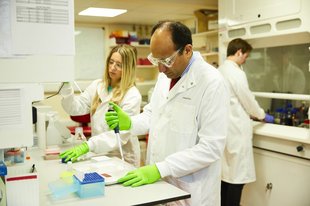Screening for Ovarian Cancer: A Long but Hopeful Journey

Written by Professor Ahmed, whose research is funded by Ovarian Cancer Action.
Without a doubt, ovarian cancer stands as one of the most devastating diseases we face today. Late diagnosis is a formidable challenge, one that my research group is firmly determined to confront.
In research, the fruits of our labour do not manifest instantly; they emerge after countless hours of commitment. However, when a breakthrough occurs, the sense of accomplishment is profound.
One such moment that I can think of, is the discovery of the prevalence of the SOX2 protein in the fallopian tubes of ovarian cancer patients and those at high risk. This finding holds immense potential, offering a path towards the development of screening tests that can detect ovarian cancer at its earliest, most treatable stage.
The journey to improve the lives of women battling ovarian cancer continues. I vividly recall a young patient, merely 22 years old, who faced an exceedingly rare form of ovarian cancer resistant to chemotherapy. Her unwavering zest for life and enduring hope remain a constant source of inspiration.
And because of her determination, I am driven to tirelessly seek new avenues to combat this disease.
Advancing towards a new screening tool
The question of a screening tool looms large.
Early detection is paramount in enhancing ovarian cancer survival rates. In cervical cancer, we deeply understand the origin and progression of pre-cancerous cells, leading to effective screening through the cervical smear test. Unlocking a similar understanding of ovarian cancer represents a crucial step towards developing a screening tool for early detection.
That is why today, my team is tirelessly working to unravel the early stages of ovarian cancer development and pioneer the world’s first screening tool for this disease. And the discovery of the SOX2 protein prevalence in fallopian tubes, which I mentioned before, has already provided invaluable insights.

Professor Ahmed.
Where are we today?
Using cutting-edge technology, we are delving into the intricacies of various cell types within the fallopian tubes to comprehend how and why they become cancerous. Already, we have identified two key molecules that contribute to the initiation of ovarian cancer.
Furthermore, our analysis of the DNA from over 300 non-cancerous fallopian tubes compared to cancerous ones, suggests that genetic markers alone are insufficient to cause the transformation of healthy cells into cancerous ones.
This discovery brings us closer to constructing a comprehensive narrative of the journey from healthy cells to cancer cells in ovarian cancer. By identifying critical molecules involved in this early transformation, we can uncover new markers that have the potential to revolutionise pre-cancer detection.
Hope for the future
Our research journey continues, and I know we can’t undertake this endeavour alone. So I would like to thank everyone who has supported Ovarian Cancer Action because it’s thanks to you that we can bring hope to future generations of women.
By unravelling the complexities of ovarian cancer, Professor Ahmed and his team aims to revolutionise pre-cancer detection and bring hope to future generations of women. Donate today and help fund our next breakthrough. Together, we are unbreakable.